Hard Facts 05 2017 (May)
Create successful ePaper yourself
Turn your PDF publications into a flip-book with our unique Google optimized e-Paper software.
Raj Malhotra’s IAS Study Group<br />
an Indian launcher is used to place New Delhi's communication satellites. Today India uses the French<br />
Ariane-5 rocket launched from Kourou in South America to place its heavy 4 ton class of communication<br />
satellites. The Polar Satellite Launch Vehicle (PSLV) failed on its maiden launch in 1993 and since then it<br />
has had 38 consecutively successful launches and the Geosynchronous Satellite Launch Vehicle Mk-1<br />
(GSLV Mk-1) failed in 2001 and since then it has 11 launches with half of them successful.<br />
Space fairing is a very risky business and all nations the US, France and Japan and even the new private<br />
companies have had failures in recent times like the spectacular Falcon-9 rocket in 2016.<br />
India already has two operational rockets — the workhorse PSLV that can hoist satellites of 1.5 tons into<br />
space and was the preferred vehicle for India's maiden mission to Moon and Mars.<br />
The second — the Geosynchronous Satellite Launch Vehicle Mark II can hoist 2 ton class of satellites and<br />
because of its repeated failures it was dubbed 'the naughty boy of ISRO'.<br />
Between them, ISRO has done 50 launches and recently even earned a world record by successfully<br />
placing 104 satellites in orbit.<br />
The new GSLV-Mk III is an all new vehicle designed and developed in India and in 2014 a sub-orbital<br />
successful test of this vehicle was conducted to understand how it performs in the atmosphere. The<br />
rocket never went into space but helped test India's future astronaut capsule. It had a dummy cryogenic<br />
engine and was a single stage vehicle.<br />
Even though the GSLV-Mk III is 43-m-tall, making it the shortest of the three big Indian rockets, it carries<br />
a huge punch as it weighs almost 1.5 times heavier than India's next biggest rocket the GSLV Mk-2 and<br />
almost twice as heavy as India's PSLV.<br />
This monster rocket has an elegant design and is capable of carrying loads equal to the weight of two<br />
sports utility vehicles or SUVs into space.<br />
The massive first stage along with strap-on boosters weighs 610 tons and comprises multiple engines all<br />
firing nearly simultaneously. It is the second stage which is all together a new animal for this mammoth<br />
rocket, it is a novel Indian cryogenic engine that weighs about 30 tons.<br />
The new cryogenic engine is being tested on a fully functional rocket for the first time and it is the<br />
development of this technology that uses liquid oxygen and liquid hydrogen as propellant is what took<br />
more than 15 years for Indians to master.<br />
Zika detected in India: Gujarat Health Minister requests for calm<br />
With cases of Zika virus being reported from Ahmedabad, Gujarat government asserted that there was no need<br />
to be worried as actions have been taken in accordance to the guidelines of World Health Organisation (WHO)<br />
and the Government of India. The ministry clarified that only three Zika cases have been detected in a round of<br />
50, 000 tests, adding that no mosquitoes were detected positive. The state health departments are all following<br />
standard protocols on the same. According to the WHO, "One sample from a 64-year-old male presenting with<br />
febrile illness of 8 days' duration was found to be positive for Zika virus at BJMC, Ahmedabad. This is the first<br />
Zika positive case reported through AFI surveillance at BJMC, Ahmedabad, Gujarat State." Another case was<br />
reported by a 34-year-old female, who delivered a clinically well baby, at the BJMC in Ahmedabad on November<br />
9 in 2016 and her sample was referred to the Viral Research & Diagnostic Laboratory (VRDL) at the BJMC for<br />
dengue testing and thereafter found to be positive for Zika Virus. The sample was re-confirmed as Zika Virus<br />
positive by RT-PCR and sequencing at NIV, Pune, as per the reports. The third sample, taken from a 22-year-old<br />
pregnant female in her 37th week of pregnancy, has also been tested positive for Zika virus disease.<br />
35 | P a g e # 1 1 1 0 , A d j a c e n t Y M C A , S e c t o r 1 1 - C , C h a n d i g a r h P h : 9 8 1 4 7 - 1 1 6 6 1





